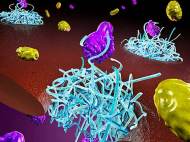Researchers achieved selective transport across a biomimetic nanopore
 Researchers at Delft University of Technology and the University of Basel have created a biomimetic nanopore that provides a unique test and measurement platform for the way that proteins move into a cell’s nucleus. The biomimetic pore is fully functional and able to act selective, thus it can be used as a testing platform for studies of drug delivery into a cell’s nucleus.
Researchers at Delft University of Technology and the University of Basel have created a biomimetic nanopore that provides a unique test and measurement platform for the way that proteins move into a cell’s nucleus. The biomimetic pore is fully functional and able to act selective, thus it can be used as a testing platform for studies of drug delivery into a cell’s nucleus.
Upon testing the transport of individual proteins through the biomimetic pore, the researchers found that most proteins cannot move through, but some specific ones can indeed pass. This is the hallmark of the intriguing selectivity that is also found in natural pores.
“Human cells have a nucleus, and proteins and RNA need to get in and out. This is regulated by small holes, called nuclear pore complexes. These are essential biological pores that act as gatekeepers of the cell nucleus. They transport proteins and RNA in and out of the nucleus in a highly selective manner, which means that some go through but others are blocked from passing”, said Professor Cees Dekker, director of the Kavli Institute of Nanoscience at Delft and lead researcher. “There is much debate on how this intriguing selectivity is achieved. Given the fact that it is very difficult to perform high-resolution measurements in the complex environment of the living cell, the exact mechanism is hard to resolve.”
Dekker’s research group collaborated with the group of dr. Roderick Lim of the University of Basel, to create a biomimetic nanopore. The group of dr. Roderick Lim purified the nuclear pore proteins and Dekkers group made the biomimetic nanopores of these by attaching these proteins to small holes in a solid-state support.
“One promising approach to study this nuclear transport is biomimetics – the development of synthetic systems that imitate biological structures and processes. Advances in nanotechnology now make it possible to study and shape matter at the nanometer scale, opening the way to imitate biological structures at the molecular level to both study and harness their ingenuity”, said Dekker.
The new research, performed by Stefan Kowalczyk, a graduate student in Dekkers lab, demonstrates that it is possible to establish a biomimetic nuclear pore and to monitor transport of individual proteins across the pore. Importantly, the biomimetic pore exhibits strong selectivity – it allows some types of proteins to pass while restricting passage to other types of proteins – just like the natural nuclear pore complex. The researchers also found a differing degree of selectivity was found, depending on which exact nuclear pore proteins were used to functionalize the pore.
For more information, you can read the article published in the Nature nanotechnology named: “Single-molecule transport across an individual biomimetic nuclear pore complex”.









Leave your response!